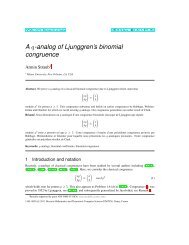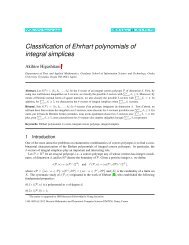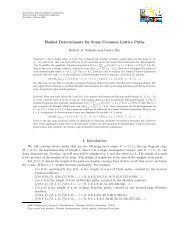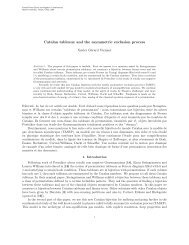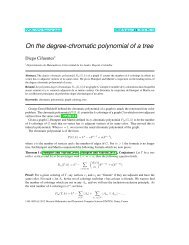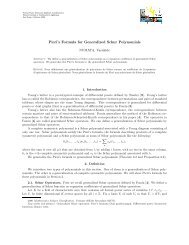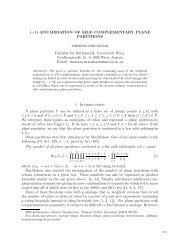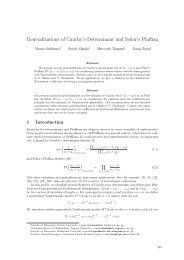Euler's partition theorem and the combinatorics of -sequences
Euler's partition theorem and the combinatorics of -sequences
Euler's partition theorem and the combinatorics of -sequences
You also want an ePaper? Increase the reach of your titles
YUMPU automatically turns print PDFs into web optimized ePapers that Google loves.
Euler’s <strong>partition</strong> <strong><strong>the</strong>orem</strong> <strong>and</strong> <strong>the</strong><br />
<strong>combinatorics</strong> <strong>of</strong> l-<strong>sequences</strong><br />
Carla D. Savage<br />
North Carolina State University<br />
June 26, 2008
Inspiration<br />
BME1 Mireille Bousquet-Mélou, <strong>and</strong> Kimmo Eriksson, Lecture hall<br />
<strong>partition</strong>s,<br />
Ramanujan. J., 1:1, 1997, 101-111.<br />
BME2 Mireille Bousquet-Mélou, <strong>and</strong> Kimmo Eriksson, Lecture hall<br />
<strong>partition</strong>s II,<br />
Ramanujan. J., 1:2, 1997, 165-185.<br />
Reference<br />
SY07 C. D. S. <strong>and</strong> Ae Ja Yee, Euler’s <strong>partition</strong> <strong><strong>the</strong>orem</strong> <strong>and</strong> <strong>the</strong><br />
<strong>combinatorics</strong> <strong>of</strong> l-<strong>sequences</strong>,<br />
JCTA, 2007, to appear, available online.<br />
LS08 Nicholas Loehr, <strong>and</strong> C. D. S. Notes on l-nomials, in<br />
preparation.
Overview<br />
Euler’s <strong>partition</strong> <strong><strong>the</strong>orem</strong>
Overview<br />
1, 2, 3, . . .<br />
l-<strong>sequences</strong><br />
Euler’s <strong>partition</strong> <strong><strong>the</strong>orem</strong>
Overview<br />
1, 2, 3, . . .<br />
l-<strong>sequences</strong><br />
Euler’s <strong>partition</strong> <strong><strong>the</strong>orem</strong><br />
The l-Euler <strong><strong>the</strong>orem</strong>
Overview<br />
1, 2, 3, . . .<br />
l-<strong>sequences</strong><br />
Euler’s <strong>partition</strong> <strong><strong>the</strong>orem</strong><br />
The l-Euler <strong><strong>the</strong>orem</strong><br />
Lecture hall <strong>partition</strong>s<br />
l-Lecture hall <strong>partition</strong>s
Overview<br />
1, 2, 3, . . .<br />
l-<strong>sequences</strong><br />
Euler’s <strong>partition</strong> <strong><strong>the</strong>orem</strong><br />
The l-Euler <strong><strong>the</strong>orem</strong><br />
Lecture hall <strong>partition</strong>s<br />
l-Lecture hall <strong>partition</strong>s<br />
Binomial coefficients<br />
l-nomial coefficients
Euler’s Partition Theorem:<br />
The number <strong>of</strong> <strong>partition</strong>s <strong>of</strong> an integer N into odd parts is equal<br />
to <strong>the</strong> number <strong>of</strong> <strong>partition</strong>s <strong>of</strong> N into distinct parts.<br />
Example: N = 8<br />
Odd parts:<br />
(7,1) (5,3) (5,1,1,1) (3,3,1,1) (3,1,1,1,1,1) (1,1,1,1,1,1,1,1)<br />
Distinct Parts:<br />
(8) (7,1) (6,2) (5,3) (5,2,1) (4,3,1)
Sylvester’s Bijection
Sylvester’s Bijection
l-<strong>sequences</strong><br />
For integer l ≥ 2, define <strong>the</strong> sequence {a n<br />
(l) } n≥1 by<br />
a (l)<br />
n<br />
= la (l)<br />
n−1 − a(l) n−2 ,<br />
with initial conditions a (l)<br />
1<br />
= 1, a (l)<br />
2<br />
= l.
l-<strong>sequences</strong><br />
For integer l ≥ 2, define <strong>the</strong> sequence {a n<br />
(l) } n≥1 by<br />
a (l)<br />
n<br />
= la (l)<br />
n−1 − a(l) n−2 ,<br />
with initial conditions a (l)<br />
1<br />
= 1, a (l)<br />
2<br />
= l.<br />
{a (3)<br />
n } = 1, 3, 8, 21, 55, 144, 377, . . .<br />
{a (2)<br />
n } = 1, 2, 3, 4, 5, 6, 7, . . .
l-<strong>sequences</strong><br />
For integer l ≥ 2, define <strong>the</strong> sequence {a n<br />
(l) } n≥1 by<br />
a (l)<br />
n<br />
= la (l)<br />
n−1 − a(l) n−2 ,<br />
with initial conditions a (l)<br />
1<br />
= 1, a (l)<br />
2<br />
= l.<br />
{a (3)<br />
n } = 1, 3, 8, 21, 55, 144, 377, . . .<br />
{a (2)<br />
n } = 1, 2, 3, 4, 5, 6, 7, . . .<br />
(These are <strong>the</strong> (k, l) <strong>sequences</strong> in [BME2] with k = l = l.)
l ≥ 2<br />
The l-Euler <strong><strong>the</strong>orem</strong> [BME2]: The number <strong>of</strong> <strong>partition</strong>s <strong>of</strong> an<br />
integer N into parts from <strong>the</strong> set<br />
{a (l)<br />
0<br />
+ a (l)<br />
1 , a(l) 1<br />
+ a (l)<br />
2 , a(l) 2<br />
+ a (l)<br />
3 , . . .}<br />
is <strong>the</strong> same as <strong>the</strong> number <strong>of</strong> <strong>partition</strong>s <strong>of</strong> N in which <strong>the</strong> ratio <strong>of</strong><br />
consecutive parts is greater than<br />
Pro<strong>of</strong>: via lecture hall <strong>partition</strong>s.<br />
c l = l + √ l 2 − 4<br />
2
l = 2<br />
The l-Euler <strong><strong>the</strong>orem</strong> [BME2]: The number <strong>of</strong> <strong>partition</strong>s <strong>of</strong> an<br />
integer N into parts from <strong>the</strong> set<br />
{0 + 1, 1 + 2, 2 + 3, . . .} = {1, 3, 5, . . .}<br />
is <strong>the</strong> same as <strong>the</strong> number <strong>of</strong> <strong>partition</strong>s <strong>of</strong> N in which <strong>the</strong> ratio <strong>of</strong><br />
consecutive parts is greater than<br />
c 2 = 2 + √ 2 2 − 4<br />
2<br />
= 1
l = 3<br />
The l-Euler <strong><strong>the</strong>orem</strong> [BME2]: The number <strong>of</strong> <strong>partition</strong>s <strong>of</strong> an<br />
integer N into parts from <strong>the</strong> set<br />
{0 + 1, 1 + 3, 3 + 8, . . .} = {1, 4, 11, 29, . . .}<br />
is <strong>the</strong> same as <strong>the</strong> number <strong>of</strong> <strong>partition</strong>s <strong>of</strong> N in which <strong>the</strong> ratio <strong>of</strong><br />
consecutive parts is greater than<br />
c 3 = 3 + √ 3 2 − 4<br />
2<br />
= (3 + √ 5)/2
l = 3<br />
The l-Euler <strong><strong>the</strong>orem</strong> [BME2]: The number <strong>of</strong> <strong>partition</strong>s <strong>of</strong> an<br />
integer N into parts from <strong>the</strong> set<br />
{0 + 1, 1 + 3, 3 + 8, . . .} = {1, 4, 11, 29, . . .}<br />
is <strong>the</strong> same as <strong>the</strong> number <strong>of</strong> <strong>partition</strong>s <strong>of</strong> N in which <strong>the</strong> ratio <strong>of</strong><br />
consecutive parts is greater than<br />
c 3 = 3 + √ 3 2 − 4<br />
2<br />
= (3 + √ 5)/2<br />
Stanley: bijection?
Θ (l) : Bijection for <strong>the</strong> l-Euler Theorem [SY07]<br />
Given a <strong>partition</strong> µ into parts in<br />
{a 0 + a 1 , a 1 + a 2 , a 2 + a 3 , . . .}<br />
construct λ = (λ 1 , λ 2 , . . .) by inserting <strong>the</strong> parts <strong>of</strong> µ in nonincreasing<br />
order as follows:<br />
To insert a k−1 + a k into (λ 1 , λ 2 , . . .):<br />
If k = 1, <strong>the</strong>n add a 1 to λ 1 ;<br />
o<strong>the</strong>rwise, if (λ 1 + a k − a k−1 ) > c l (λ 2 + a k−1 − a k−2 ),<br />
add a k − a k−1 to λ 1 , add a k−1 − a k−2 to λ 2 ;<br />
recursively insert a k−2 + a k−1 into (λ 3 , λ 4 , . . .)<br />
o<strong>the</strong>rwise,<br />
add a k to λ 1 , <strong>and</strong> add a k−1 to λ 2 .
The insertion step<br />
To insert a k + a k−1 into (λ 1 , λ 2 , λ 3 , λ 4 , . . .) ei<strong>the</strong>r do<br />
(i) (λ 1 + a k , λ 2 + a k−1 , λ 3 , λ 4 , . . .)<br />
or<br />
(ii) (λ 1 + (a k − a k−1 ), λ 2 + (a k−1 − a k−2 ),<br />
insert (a k−1 + a k−2 )into(λ 3 , λ 4 , . . .))<br />
How to decide?<br />
Do (ii) if <strong>the</strong> ratio <strong>of</strong> first two parts is okay, o<strong>the</strong>rwise do (i).
Interpretation <strong>of</strong> a (l)<br />
n<br />
Define T n<br />
(l) : set <strong>of</strong> l-ary strings <strong>of</strong> length n that do not contain<br />
(l − 1)(l − 2) ∗ (l − 1)<br />
T (3)<br />
1<br />
= {0, 1, 2} |T (3)<br />
1<br />
| = 3<br />
T (3)<br />
2<br />
= {00, 01, 02, 11, 10, 12, 20, 21} |T (3)<br />
2<br />
| = 8<br />
T (3)<br />
3<br />
: all 27 except 220, 221, 222, 022, 122, <strong>and</strong> 212.<br />
Theorem |T (l)<br />
n<br />
| = a(l) n+1 .<br />
|T (3)<br />
3<br />
| = 27 − 6 = 21
Binary numeration system<br />
1 0 1 1 0 → 1 ∗ 2 4 + 0 ∗ 2 3 + 1 ∗ 2 2 + 1 ∗ 2 1 + 0 ∗ 2 0 = 22<br />
Ternary numeration system<br />
(unique representation)<br />
1 0 2 1 1 → 1 ∗ 3 4 + 0 ∗ 3 3 + 2 ∗ 3 2 + 1 ∗ 3 1 + 1 ∗ 3 0 = 138<br />
(unique representation)
Binary numeration system<br />
1 0 1 1 0 → 1 ∗ 2 4 + 0 ∗ 2 3 + 1 ∗ 2 2 + 1 ∗ 2 1 + 0 ∗ 2 0 = 22<br />
Ternary numeration system<br />
(unique representation)<br />
1 0 2 1 1 → 1 ∗ 3 4 + 0 ∗ 3 3 + 2 ∗ 3 2 + 1 ∗ 3 1 + 1 ∗ 3 0 = 138<br />
A Fraenkel numeration system: ternary, but ...<br />
(unique representation)<br />
1 0 2 1 1 → 1 ∗ 55 + 0 ∗ 21 + 2 ∗ 8 + 1 ∗ 3 + 1 ∗ 1 = 75
Binary numeration system<br />
1 0 1 1 0 → 1 ∗ 2 4 + 0 ∗ 2 3 + 1 ∗ 2 2 + 1 ∗ 2 1 + 0 ∗ 2 0 = 22<br />
Ternary numeration system<br />
(unique representation)<br />
1 0 2 1 1 → 1 ∗ 3 4 + 0 ∗ 3 3 + 2 ∗ 3 2 + 1 ∗ 3 1 + 1 ∗ 3 0 = 138<br />
A Fraenkel numeration system: ternary, but ...<br />
(unique representation)<br />
1 0 2 1 1 → 1 ∗ 55 + 0 ∗ 21 + 2 ∗ 8 + 1 ∗ 3 + 1 ∗ 1 = 75<br />
0 0 2 1 2 → 0 ∗ 55 + 0 ∗ 21 + 2 ∗ 8 + 1 ∗ 3 + 2 ∗ 1 = 21<br />
0 1 0 0 0 → 0 ∗ 55 + 1 ∗ 21 + 0 ∗ 8 + 0 ∗ 3 + 0 ∗ 1 = 21
Binary numeration system<br />
1 0 1 1 0 → 1 ∗ 2 4 + 0 ∗ 2 3 + 1 ∗ 2 2 + 1 ∗ 2 1 + 0 ∗ 2 0 = 22<br />
Ternary numeration system<br />
(unique representation)<br />
1 0 2 1 1 → 1 ∗ 3 4 + 0 ∗ 3 3 + 2 ∗ 3 2 + 1 ∗ 3 1 + 1 ∗ 3 0 = 138<br />
A Fraenkel numeration system: ternary, but ...<br />
(unique representation)<br />
1 0 2 1 1 → 1 ∗ 55 + 0 ∗ 21 + 2 ∗ 8 + 1 ∗ 3 + 1 ∗ 1 = 75<br />
0 0 2 1 2 → 0 ∗ 55 + 0 ∗ 21 + 2 ∗ 8 + 1 ∗ 3 + 2 ∗ 1 = 21<br />
0 1 0 0 0 → 0 ∗ 55 + 1 ∗ 21 + 0 ∗ 8 + 0 ∗ 3 + 0 ∗ 1 = 21<br />
but unique representation by ternary strings with no 21*2
Theorem [Fraenkel 1985] Every nonnegative integer has a unique<br />
(up to leading zeroes) representation as an l-ary string which does<br />
not contain <strong>the</strong> pattern<br />
(l − 1) (l − 2) ∗ (l − 1).<br />
Pro<strong>of</strong> Show that<br />
is a bijection<br />
f : b n b n−1 . . . b 1<br />
−→<br />
n∑<br />
b i a i<br />
i=1<br />
f : T (l)<br />
n<br />
−→ {0, 1, 2, . . . a (l)<br />
n+1 − 1}.<br />
The l-representation <strong>of</strong> an integer x is<br />
[x] = f −1 (x).
Can revise bijection<br />
To insert a k + a k+1 into (λ 1 , λ 2 , λ 3 , λ 4 , . . .) ei<strong>the</strong>r do<br />
(i) (λ 1 + a k , λ 2 + a k−1 , λ 3 , λ 4 , . . .)<br />
or<br />
(ii) (λ 1 + (a k − a k−1 ), λ 2 + (a k−1 − a k−2 ),<br />
How to decide?<br />
insert (a k−1 + a k−2 )into(λ 3 , λ 4 , . . .))<br />
Do (i) if it does not create a carry in Fraenkel arithmetic;<br />
o<strong>the</strong>rwise do (ii).<br />
So, insertion becomes a 2-d form <strong>of</strong> Fraenkel arithmetic.
Lecture Hall Partitions
The Lecture Hall Theorem [BME1] The generating function for<br />
integer <strong>sequences</strong> λ 1 , λ 2 , . . . , λ n satisfying:<br />
is<br />
L n :<br />
λ 1<br />
n ≥ λ 2<br />
n − 1 ≥ . . . ≥ λ n<br />
1 ≥ 0<br />
L n (q) =<br />
n∏<br />
i=1<br />
1<br />
1 − q 2i−1
The Lecture Hall Theorem [BME1] The generating function for<br />
integer <strong>sequences</strong> λ 1 , λ 2 , . . . , λ n satisfying:<br />
is<br />
L n :<br />
λ 1<br />
n ≥ λ 2<br />
n − 1 ≥ . . . ≥ λ n<br />
1 ≥ 0<br />
L n (q) =<br />
n∏<br />
i=1<br />
1<br />
1 − q 2i−1<br />
lim n→∞ (Lecture Hall Theorem) = Euler’s Theorem<br />
since<br />
λ 1<br />
n ≥ λ 2<br />
n − 1 ≥ . . . ≥ λ n<br />
1<br />
n∏<br />
i=1<br />
≥ 0 −→ <strong>partition</strong>s into distinct parts<br />
1<br />
−→ <strong>partition</strong>s into odd parts<br />
1 − q2i−1
Let {a n } = {a (l)<br />
n }.<br />
The l-Lecture Hall Theorem [BME2]: The generating function<br />
for integer <strong>sequences</strong> λ 1 , λ 2 , . . . , λ n satisfying:<br />
L (l)<br />
n :<br />
λ 1<br />
a n<br />
≥ λ 2<br />
a n−1<br />
≥ . . . ≥ λ n−1<br />
a 2<br />
≥ λ n<br />
a 1<br />
≥ 0<br />
is<br />
L (l)<br />
n (q) =<br />
n∏<br />
i=1<br />
1<br />
(1 − q a i−1 +a i )<br />
lim n→∞ (l-Lecture Hall Theorem) = l-Euler Theorem<br />
since as n → ∞,<br />
a n /a n−1 → c l
Θ (l)<br />
n : Bijection for <strong>the</strong> l-Lecture Hall Theorem<br />
Given a <strong>partition</strong> µ into parts in<br />
{a 0 + a 1 , a 1 + a 2 , a 2 + a 3 , . . . , a n−1 + a n }<br />
construct λ = (λ 1 , λ 2 , . . . , λ n ) by inserting <strong>the</strong> parts <strong>of</strong> µ in nonincreasing<br />
order as follows:<br />
To insert a k−1 + a k into (λ 1 , λ 2 , . . . , λ n ):<br />
If k = 1, <strong>the</strong>n add a 1 to λ 1 ;<br />
o<strong>the</strong>rwise, if (λ 1 + a k − a k−1 ) ≥ (a n /a n−1 )(λ 2 + a k−1 − a k−2 ),<br />
add a k − a k−1 to λ 1 , add a k−1 − a k−2 to λ 2 ;<br />
recursively insert a k−2 + a k−1 into (λ 3 , λ 4 , . . . , λ n )<br />
o<strong>the</strong>rwise,<br />
add a k to λ 1 , <strong>and</strong> add a k−1 to λ 2 .
Relationship between bijections
Truncated lecture hall <strong>partition</strong>s<br />
L (l)<br />
n,k<br />
:<br />
λ 1<br />
n ≥ λ 2<br />
n − 1 ≥ · · · ≥<br />
λ k−1<br />
n − k + 2 ≥<br />
λ k<br />
n − k + 1 > 0<br />
Theorem: [Corteel,S 2004]<br />
[<br />
L (l)<br />
n,k<br />
(q) = q(k+1 2 ) n<br />
k<br />
]<br />
q<br />
(−q n−k+1 ; q) k<br />
(q 2n−k+1 ; q) k<br />
,<br />
where (a; q) n = (1 − a)(1 − aq) · · · (1 − aq n−1 )<br />
Analog for l-lecture hall <strong>partition</strong>s?
Truncated lecture hall <strong>partition</strong>s<br />
L (l)<br />
n,k,j : j ≥ λ 1<br />
n ≥ λ 2<br />
n − 1 ≥ · · · ≥<br />
λ k−1<br />
n − k + 2 ≥<br />
λ k<br />
n − k + 1 > 0<br />
Theorem: [Corteel,S 2004]<br />
[<br />
L (l)<br />
n,k<br />
(q) = q(k+1 2 ) n<br />
k<br />
Theorem [Corteel,Lee,S 2005]<br />
( )<br />
L (l) n<br />
n,k,j (1) = jk k<br />
]<br />
q<br />
(−q n−k+1 ; q) k<br />
(q 2n−k+1 ; q) k<br />
,<br />
where (a; q) n = (1 − a)(1 − aq) · · · (1 − aq n−1 )<br />
Analog for l-lecture hall <strong>partition</strong>s?
Theorem [Corteel,S 2004] Given positive integers s 1 , . . . , s n , <strong>the</strong><br />
generating function for <strong>the</strong> <strong>sequences</strong> λ 1 , . . . , λ n satisfying<br />
is<br />
λ 1<br />
s 1<br />
≥ λ 2<br />
s 2<br />
≥ · · · ≥ λ n−1<br />
s n−1<br />
≥ λ n<br />
s n<br />
≥ 0<br />
∑ s2 −1 ∑ s3 −1<br />
z 2 =0 z 3 =0 · · · ∑s n−1<br />
s 1 z 2<br />
z n=0 q⌈ s 2<br />
∏ n<br />
i=1 (1 − qb i )<br />
⌉+ P n<br />
i=2 z i<br />
∏ n−1<br />
i=2 qb i ⌈ z i+1 − z i ⌉<br />
s i+1 s i<br />
where b 1 = 1 <strong>and</strong> for 2 ≤ i ≤ n, b i = s 1 + s 2 + · · · + s i .<br />
Corollary As q → 1, (1 − q) n × this gf −→<br />
s 2 s 3 · · · s<br />
∏ n<br />
n<br />
i=1 b .<br />
i
Truncated l-lecture hall <strong>partition</strong>s → l-nomials<br />
Corollary For l-sequence {a i }:<br />
L (l)<br />
n+k,k : λ 1<br />
a n+k<br />
≥ λ 2<br />
a n+k−1<br />
≥<br />
λ k<br />
a n+1<br />
> 0<br />
but<br />
L (l)<br />
n+k,k<br />
(q) =?<br />
) (l)<br />
lim ((1 −<br />
q→1 q)k L (l)<br />
n+k,k (q)) =<br />
( n<br />
k<br />
(p 1 p 2 · · · p k )(p n+k p n+k−1 · · · p n+1 )<br />
where p i = a i + a i−1<br />
<strong>and</strong><br />
( n<br />
k<br />
) (l)<br />
is <strong>the</strong> l-nomial ...
The l-nomial coefficient<br />
Example<br />
( n (l)<br />
=<br />
k) a(l) n a (l)<br />
n−1 · · · a(l)<br />
n−k+1<br />
a (l)<br />
k<br />
a(l) k−1 · · · a(l) 1<br />
.<br />
( 9<br />
4<br />
) (3)<br />
=<br />
2584 ∗ 987 ∗ 377 ∗ 144<br />
21 ∗ 8 ∗ 3 ∗ 1<br />
= 174, 715, 376.<br />
Theorem [Lucas 1878]<br />
( n<br />
) (l)<br />
k is an integer.<br />
like Fibonomials, e.g. Ron Knott’s web page:<br />
http://www.mcs.surrey.ac.uk/Personal/R.Knott/Fibonacci/Fibonomials.html
“Pascal-like” triangle for <strong>the</strong> l-nomial coefficient:<br />
1<br />
1 1<br />
1 3 1<br />
1 8 8 1<br />
1 21 56 21 1<br />
1 55 385 385 55 1<br />
1 144 2640 6930 2640 144 1<br />
Theorem<br />
( ) n (l) ( )<br />
= (a (l) n − 1 (l) (<br />
k<br />
k+1 − a(l) k ) + (a (l)<br />
n − 1<br />
k<br />
n−k − a(l) n−k−1 ) k − 1<br />
) (l)
Let u l <strong>and</strong> v l be <strong>the</strong> roots <strong>of</strong> <strong>the</strong> polynomial x 2 − lx + 1:<br />
Then<br />
u l = l + √ l 2 − 4<br />
; v l = l − √ l 2 − 4<br />
2<br />
2<br />
u l + v l = l; u l v l = 1.<br />
a (l)<br />
n = un l − v n l<br />
u l − v l<br />
.
Let u l <strong>and</strong> v l be <strong>the</strong> roots <strong>of</strong> <strong>the</strong> polynomial x 2 − lx + 1:<br />
Then<br />
u l = l + √ l 2 − 4<br />
; v l = l − √ l 2 − 4<br />
2<br />
2<br />
u l + v l = l; u l v l = 1.<br />
a (l)<br />
n = un l − v n l<br />
u l − v l<br />
.<br />
For real r, define<br />
∆ (l)<br />
r<br />
= ul r + v l r . Then for integer n<br />
∆ (l)<br />
n<br />
= a (l)<br />
n+1 − a(l) n−1 . (∆ is <strong>the</strong> l analog <strong>of</strong> “2”.)
Let u l <strong>and</strong> v l be <strong>the</strong> roots <strong>of</strong> <strong>the</strong> polynomial x 2 − lx + 1:<br />
Then<br />
u l = l + √ l 2 − 4<br />
; v l = l − √ l 2 − 4<br />
2<br />
2<br />
u l + v l = l; u l v l = 1.<br />
a (l)<br />
n = un l − v n l<br />
u l − v l<br />
.<br />
For real r, define<br />
∆ (l)<br />
r<br />
= ul r + v l r . Then for integer n<br />
∆ (l)<br />
n<br />
= a (l)<br />
n+1 − a(l) n−1 . (∆ is <strong>the</strong> l analog <strong>of</strong> “2”.)<br />
(∆ (l)<br />
n/2 )2 = u n l + 2(u lv l ) n/2 + v n l = ∆ (l)<br />
n + 2.<br />
∆ (l)<br />
−r = u−r l<br />
+ v −r<br />
l<br />
= vl r + ur l = ∆(l) r
A 3-term recurrence for <strong>the</strong> l-nomial [LS]<br />
( n<br />
k<br />
) (l)<br />
=<br />
( n − 2<br />
k<br />
) (l)<br />
+ ∆ (l)<br />
n−1<br />
( ) n − 2 (l)<br />
+<br />
k − 1<br />
( ) n − 2 (l)<br />
k − 2<br />
Pro<strong>of</strong>: Use identities:<br />
a (l)<br />
n+k − a(l)<br />
n−k = ∆(l) n a (l)<br />
k .<br />
a n<br />
(l) a (l)<br />
n−1 − a(l) k<br />
a(l) k−1 = a(l) n−k a(l) n+k−1 .
An l-nomial <strong><strong>the</strong>orem</strong> [LS]: An analog <strong>of</strong><br />
is<br />
n∑<br />
k=0<br />
( n<br />
k)<br />
z k = (1 + z) n<br />
n∑<br />
( ) n (l)<br />
z k =<br />
k<br />
k=0<br />
n−1<br />
∏<br />
i=0<br />
(u i−(n−1)/2<br />
l<br />
+ v i−(n−1)/2<br />
l<br />
z) =<br />
(1 + ∆ (l)<br />
1 z + z2 )(1 + ∆ (l)<br />
3 z + z2 ) · · · (1 + ∆ (l)<br />
n−1 z + z2 )<br />
(1 + z)(1 + ∆ (l)<br />
2 z + z2 )(1 + ∆ (l)<br />
4 z + z2 ) · · · (1 + ∆ (l)<br />
n−1 z + z2 )<br />
n even<br />
n odd
A coin-flipping interpretation <strong>of</strong> <strong>the</strong> l-nomial<br />
For real r, let C r<br />
(l) be a weighted coin for which <strong>the</strong> probability <strong>of</strong><br />
tails is ul r /∆(l) r <strong>and</strong> <strong>the</strong> probability <strong>of</strong> heads is vl r /∆(l) r .<br />
The probability <strong>of</strong> getting exactly k heads when tossing <strong>the</strong> n coins<br />
C (l)<br />
−(n−1)/2 ,<br />
C (l)<br />
1−(n−1)/2 ,<br />
C (l)<br />
2−(n−1)/2 , . . . , C (l)<br />
(n−1)/2 :
A coin-flipping interpretation <strong>of</strong> <strong>the</strong> l-nomial<br />
For real r, let C r<br />
(l) be a weighted coin for which <strong>the</strong> probability <strong>of</strong><br />
tails is ul r /∆(l) r <strong>and</strong> <strong>the</strong> probability <strong>of</strong> heads is vl r /∆(l) r .<br />
The probability <strong>of</strong> getting exactly k heads when tossing <strong>the</strong> n coins<br />
C (l)<br />
−(n−1)/2 ,<br />
C (l)<br />
1−(n−1)/2 ,<br />
C (l)<br />
2−(n−1)/2 , . . . , C (l)<br />
(n−1)/2 :<br />
( n<br />
k) (l)<br />
∆ (l)<br />
−(n−1)/2 ∆(l) 1−(n−1)/2 · · · ∆(l) (n−1)/2−1 ∆(l) (n−1)/2<br />
∆ (l)<br />
j/2<br />
may not be an integer, but ∆(l)<br />
−j/2 ∆(l) j/2 = ∆(l) j<br />
+ 2 is.
Figure: The 8 possible results <strong>of</strong> tossing <strong>the</strong> weighted coins<br />
C (l)<br />
−1 , C (l)<br />
0 , C (l)<br />
1 . Heads (pink) are indicated with <strong>the</strong>ir “v” weight <strong>and</strong><br />
tails (blue) with <strong>the</strong>ir “u” weight. The weight <strong>of</strong> each toss is shown.
Define a q-analog <strong>of</strong> <strong>the</strong> l-nomial:<br />
a n<br />
(l) (q) = un l − v l nqn<br />
u l − v l q ;<br />
∆(l) n (q) = ul n + v l n qn<br />
[ n<br />
k<br />
] (l)<br />
q<br />
= a(l) n (q) a (l)<br />
n−1<br />
(q) · · · a(l)<br />
n−k+1 (q)<br />
a (l) (q) a(l) (q) · · · a(l)<br />
1 (q) .<br />
k<br />
k−1<br />
Then<br />
[ n<br />
k<br />
] (l)<br />
q<br />
= q k [ n − 2<br />
k<br />
] (l)<br />
q<br />
[ ]<br />
+ ∆ (l) n − 2 (l)<br />
n−1 (q) k − 1<br />
q<br />
[ ] n − 2 (<br />
+ q n−k k − 2<br />
q<br />
<strong>and</strong><br />
n∑<br />
[ n<br />
k<br />
k=0<br />
] (l)<br />
q<br />
q k(k+1)/2 z k = α n (q, z)<br />
⌊n/2⌋<br />
∏<br />
i=1<br />
(1 + zq i ∆ (l)<br />
n−2i+1 (q) + z2 q n+1 ).<br />
where α n (q, z) = 1 if n is even; (1 + zq (n+1)/2 ) if n is odd.
Pro<strong>of</strong>s can be derived from this <strong>partition</strong>-<strong>the</strong>oretic interpretation:
Ano<strong>the</strong>r q-analog <strong>of</strong> <strong>the</strong> l-nomial<br />
Let a n (q) = (1 − q an )/(1 − q). Then<br />
[ n<br />
k<br />
] (l)<br />
q<br />
= ∑ (µ,f )<br />
q shapeweight(µ) q fillweight(µ,f )<br />
where <strong>the</strong> sum is over all pairs (µ, f ) such µ is a <strong>partition</strong> in<br />
[k × (n − k)] <strong>and</strong> f is a filling f (i, j) <strong>of</strong> <strong>the</strong> cells <strong>of</strong> [k × (n − k)]<br />
with elements <strong>of</strong> {0, 1, . . . l − 1} so that (i) no row <strong>of</strong> µ or column<br />
<strong>of</strong> µ c contains (l − 1)(l − 2) ∗ (l − 1) <strong>and</strong> ... (a bit more)<br />
Indexing cells <strong>of</strong> k × (n − k) bottom to top, left to right:<br />
◮ cell (i, j) has a shape weight (a i − a i−1 )(a j − a j−1 )<br />
◮ shapeweight(µ) is sum <strong>of</strong> shape weights <strong>of</strong> cells in µ<br />
◮ cell (i, j) has a fill weight a i a j<br />
◮ fillweight(µ, f ) is ∑ i,j f (i, j)a ia j .<br />
(Now starting to get something related to lecture hall <strong>partition</strong>s.)
Question: Is <strong>the</strong>re an analytic pro<strong>of</strong> <strong>of</strong> <strong>the</strong> l-Euler <strong><strong>the</strong>orem</strong>?<br />
When l = 2, <strong>the</strong> st<strong>and</strong>ard approach is to show <strong>the</strong> equivalence <strong>of</strong><br />
<strong>the</strong> generating functions for <strong>the</strong> set <strong>of</strong> <strong>partition</strong>s into odd parts <strong>and</strong><br />
<strong>the</strong> set <strong>of</strong> <strong>partition</strong>s into distinct parts:<br />
∞∏ 1<br />
∞<br />
1 − q 2k−1 = ∏<br />
(1 + q k ).<br />
k=1<br />
k=1<br />
The sum/product form <strong>of</strong> Euler’s <strong><strong>the</strong>orem</strong> is<br />
∞∏<br />
k=1<br />
1<br />
∞<br />
1 − q 2k−1 = ∑<br />
k=0<br />
q k(k+1)<br />
(q; q) k<br />
Is <strong>the</strong>re an analog for <strong>the</strong> l-Euler <strong><strong>the</strong>orem</strong>? What is <strong>the</strong> sum-side<br />
generating function for <strong>partition</strong>s in which <strong>the</strong> ratio <strong>of</strong> consecutive<br />
parts is greater than c l ?
Question: When l = 2, several refinements <strong>of</strong> Euler’s <strong><strong>the</strong>orem</strong><br />
follow from Sylvester’s bijection. What refinements <strong>of</strong> <strong>the</strong> l-Euler<br />
<strong><strong>the</strong>orem</strong> can be obtained from <strong>the</strong> bijection? We have some partial<br />
answers, but here’s one we can’t answer:<br />
Sylvester showed that if, in his bijection, <strong>the</strong> <strong>partition</strong> µ into odd<br />
parts maps to λ (distinct parts), <strong>the</strong>n <strong>the</strong> number <strong>of</strong> distinct part<br />
sizes occurring in µ is <strong>the</strong> same as <strong>the</strong> number <strong>of</strong> maximal chains<br />
in λ. (A chain is a sequence <strong>of</strong> consecutive integers.) Is <strong>the</strong>re an<br />
analog for l > 2?
Question: Can we enumerate ei<strong>the</strong>r <strong>of</strong> <strong>the</strong>se finite sets:<br />
◮ The integer <strong>sequences</strong> λ 1 , . . . , λ n in which <strong>the</strong> ratio <strong>of</strong><br />
consecutive parts is greater than c l <strong>and</strong> λ 1 < a (l)<br />
n+1 ?<br />
We have a combinatorial characterization: <strong>the</strong>se can be<br />
viewed as fillings <strong>of</strong> a staircase <strong>of</strong> shape (n, n − 1, . . . , 1) such<br />
that (i) <strong>the</strong> filling <strong>of</strong> each row is an l-ary string with no<br />
(l − 1)(l − 2) ∗ (l − 1) <strong>and</strong> (ii) <strong>the</strong> rows are weakly decreasing,<br />
lexicographically. For l = 2 <strong>the</strong> answer is 2 n .<br />
◮ The integer <strong>sequences</strong> λ 1 , . . . , λ n satisfying<br />
1 ≥ λ 1<br />
a n<br />
≥ λ 2<br />
a n−1<br />
≥ . . . ≥ λ n−1<br />
a 2<br />
≥ λ n<br />
a 1<br />
≥ 0<br />
For l = 2 this is <strong>the</strong> same set as above <strong>and</strong> <strong>the</strong> answer is 2 n .
Question: What is <strong>the</strong> generating function for truncated l-lecture<br />
hall <strong>partition</strong>s?<br />
Question: What is <strong>the</strong> right q-analog <strong>of</strong> <strong>the</strong> l-nomial (<strong>and</strong> <strong>the</strong><br />
right interpretation) to explain <strong>and</strong> generalize lecture hall<br />
<strong>partition</strong>s?<br />
(We know what lecture hall <strong>partition</strong>s look like in <strong>the</strong> “l-world”.<br />
What about ordinary <strong>partition</strong>s? <strong>partition</strong>s into distinct parts?)<br />
Question: There are several q-series identities related to Euler’s<br />
<strong><strong>the</strong>orem</strong>, such as Lebesgue’s identity <strong>the</strong> Roger’s-Fine identity<br />
Cauchy’s identity Are <strong>the</strong>re l-analogs?
Sincere thanks to ...<br />
You, <strong>the</strong> audience<br />
The FPSAC08 Organizing Committee<br />
The FPSAC08 Program Committee<br />
Luc Lapointe
CanaDAM 2009<br />
2nd Canadian Discrete <strong>and</strong> Algorithmic<br />
Ma<strong>the</strong>matics Conference<br />
May 25 - 28, 2009<br />
CRM, Montreal, Quebec, Canada<br />
http://www.crm.umontreal.ca/CanaDAM2009/index.shtml
AMS 2009 Spring Sou<strong>the</strong>astern Section Meeting<br />
North Carolina State University<br />
Raleigh, NC April 4-5, 2009 (Saturday - Sunday)<br />
Some <strong>of</strong> <strong>the</strong> special sessions:<br />
◮ Applications <strong>of</strong> Algebraic <strong>and</strong> Geometric Combinatorics (Sullivant,<br />
Savage)<br />
◮ Rings, Algebras, <strong>and</strong> Varieties in Combinatorics (Hersh, Lenart,<br />
Reading)<br />
◮ Recent Advances in Symbolic Algebra <strong>and</strong> Analysis (Singer, Szanto)<br />
◮ Kac-Moody Algebras, Vertex Algebras, Quantum Groups, <strong>and</strong><br />
Applications (Bakalov, Misra, Jing)<br />
◮ Enumerative Geometry <strong>and</strong> Related Topics (Rimayi, Mihalcea)<br />
◮ Homotopical Algebra with Applications to Ma<strong>the</strong>matical Physics<br />
(Lada, Stasheff)<br />
◮ Low Dimensional Topology <strong>and</strong> Geometry (Dunfield, Etnyre, Ng)



